How to Use Haptics for Improved Perception in Human Machine Interfaces
Contributed By DigiKey's North American Editors
2022-08-30
The need for more effective human-machine interfaces (HMIs) and improved perception is driving the adoption of haptics in Industry 4.0 applications, automotive, medical and first responder systems, Internet of things (IoT) devices, wearables, and other consumer devices. For example, haptic devices can provide feedback in VR (virtual reality) or AR (augmented reality) based medical training and patient rehabilitation systems, or they can provide enhanced alerts in a steering wheel to inform drivers of potentially unsafe conditions. Haptics are also being used in combination with other HMI technologies such as sound to provide more immersive and realistic sensory interfaces.
Some of the challenges designers face when using haptics are selecting the correct haptic technology—eccentric rotating mass (ERM) or linear resonant actuator (LRA)—properly integrating it into a system to achieve the desired level of feedback, driving it, and understanding how to test its vibration, noise performance, and reliability.
This article begins with a brief review of the benefits haptic feedback can bring to several application scenarios. It then introduces haptic technology options along with real-world examples of haptic devices from PUI Audio. It discusses how to integrate haptic devices into systems including an example of a haptic driver IC, and closes by detailing methodologies for testing vibration and noise performance.
Multi-sensory interfaces
Haptics are increasingly being used in combination with visual and auditory feedback to create multi-sensory environments and enhanced interaction between humans and machines. Haptic interfaces can include clothes, gloves, touch screens, and other objects such as mobile devices and computer mice.
Multi-sensory interaction is particularly useful in environments where a non-visual HMI element such as haptics or sound can enable the user to keep focused on the task at hand, like remotely controlling machinery or surgical tools, or driving a car. Integrating haptics into HMIs also supports enhanced manual interaction with virtual environments or teleoperated remote systems. To gain the maximum benefit from integrating haptics into an HMI, designers need to understand the performance tradeoffs of haptic technologies.
Haptic device technologies
The most common haptic technologies are ERM and LRA. An ERM uses an off-center mass on the motor shaft to cause an imbalance and create vibration. ERM devices are driven with relatively simple direct current (DC) voltages. The use of DC power, combined with their relatively simple mechanical design, has several tradeoffs:
Advantages:
- Simple to drive
- Low cost
- Flexible form factor
- Simpler system integration for some designs
Disadvantages:
- High energy consumption
- Slow response
- Larger solution size
Instead of using an eccentric mass to create multi-axis vibrations, an LRA device vibrates in a linear motion using a voice coil, circular magnet, and spring. LRA devices require alternating current (AC) drives to power the voice coil. The AC creates a variable magnetic field in the voice coil that causes the magnet to move up and down. The spring connects the magnet to the device housing, transferring vibrational energy to the system. Since LRA devices are based on a voice coil and don’t rely on the brushes used in ERMs, they consume less power for a given strength of vibration. Braking can be implemented by driving an LRA device with 180° of phase shift, speeding response times.
LRA devices operate efficiently in relatively narrow resonant bands (usually ±2 to ±5 Hertz (Hz)). As a result of manufacturing tolerances, component aging, environmental conditions, and mounting considerations, the exact resonant frequency of an LRA device can vary, complicating the design of the drive circuit. LRA haptics present designers with a different set of advantages and disadvantages compared with ERM devices:
Advantages:
- Faster response time
- Higher efficiency
- Increased acceleration
- Braking is possible
- Can be smaller in size
Disadvantages:
- Resonant frequency can vary
- Challenging to drive
- Higher cost
In addition to the differences in their operation, ERM and LRA devices are available in several package styles. ERM devices can be in coin or bar packages, while LRAs are in coin, prismatic (rectangular), or barrel packages (Figure 1). Coin-style ERM and LRA devices tend to be about 8 millimeters (mm) in diameter with thicknesses of about 3 mm. Bar-type ERM haptic devices are larger, measuring about 12 mm long by 4 mm wide.
 Figure 1: ERMs are available in bar or coin packages, while LRAs come in coin, barrel, or prismatic formats. (Image source: PUI Audio)
Figure 1: ERMs are available in bar or coin packages, while LRAs come in coin, barrel, or prismatic formats. (Image source: PUI Audio)
Coin-style ERM devices
For applications such as wearables that can benefit from a coin-style ERM device, designers can use the 8 mm diameter by 3 mm thick HD-EM0803-LW20-R from PUI Audio. Specifications for the HD-EM0803-LW20-R include:
- Rated speed of 12,000 (±3,000) revolutions per minute (rpm)
- Terminal resistance of 38 ohms (Ω) (±50%)
- Input voltage of 3 volts DC
- Nominal current draw of 80 milliamperes (mA)
- Operating temperature range of -20 to +60 degrees Celsius (°C)
For devices that need to operate in more challenging thermal environments, designers can turn to the HD-EM1003-LW15-R, rated for operation from -30°C to +70°C. It has the same rated speed and is the same size as the HD-EM0803-LW20-R, and features a terminal resistance of 46 Ω (±50%) with a nominal current draw of 85 mA. Both of these coin-style ERM devices can be driven with positive or negative DC for clockwise or counterclockwise movement. They include 20 mm lead wires for flexible electrical connections and produce a maximum acoustic noise of 50 decibels ambient (dBA).
Bar ERMs
The HD-EM1206-SC-R measures 12.4 mm long by 3.8 mm wide. It has a rated speed of 12,000 (±3,000) rpm when driven with 3 volts DC. It’s rated for operation from -20 to +60°C and produces a maximum of 50 dBA of acoustic noise. Designs that require lower levels of acoustic noise can use the HD-EM1204-SC-R (Figure 2). This produces a maximum acoustic noise of only 45 dBA. It also has a higher rated speed of 13,000 (±3,000) rpm, and a wider operating temperature range of -30°C to +70°C, compared with the HD-EM1206-SC-R. Both devices have a low terminal resistance of 30 Ω (±20%) and a nominal current draw of 90 mA.
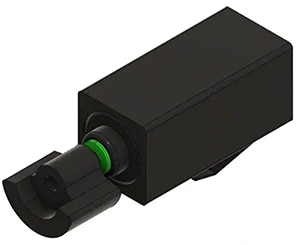 Figure 2: The HD-EM1204-SC-R ERM is suited for applications that require low acoustic noise levels. (Image source: PUI Audio)
Figure 2: The HD-EM1204-SC-R ERM is suited for applications that require low acoustic noise levels. (Image source: PUI Audio)
LRA device
Designs that require faster response times, greater energy efficiency, and stronger vibration can use PUI Audio’s 8 mm diameter by 3.2 mm high HD-LA0803-LW10-R LRA device (Figure 3). LRA devices are more precise, relative to ERM haptics. For example, the resistance of ERM devices ranges from 30 (±20%) to 46 Ω (±50%), while the resistance of the HD-LA0803-LW10-R is specified as 25 Ω (±15%). The power consumption of the HD-LA0803-LW10-R is about 180 milliwatts (mW), (2 VRMS x 90 mA), while the ERM devices discussed above consume from 240 to 270 mW. This LRA device has an operating temperature range of -20 to +70°C.
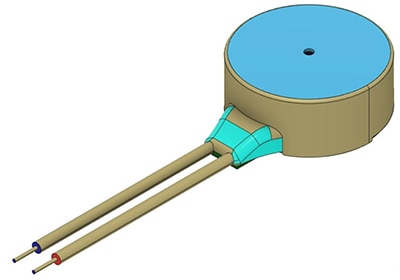 Figure 3: The HD-LA0803-LW10-R LRA combines strong vibration, fast response times, and energy efficiency. (Image source: PUI Audio)
Figure 3: The HD-LA0803-LW10-R LRA combines strong vibration, fast response times, and energy efficiency. (Image source: PUI Audio)
System integration
The use of double-sided tape is the preferred assembly method for coin-style haptic devices, and it provides the best vibration coupling to the system. Double-sided tape devices include lead wires that require through-hole connections and hand soldering to the circuit board. Bar, barrel, and prismatic devices are available with two different system integration styles: double-sided tape and spring contacts. When double-sided tape is used, these devices include hand-soldered lead wires like coin-style devices. The use of spring contacts combines the functions of vibration coupling along with electrical connectivity. The spring contacts eliminate the need for hand soldering, simplifying assembly and reducing costs. Also, the use of spring contacts can simplify field repairs.
Driving haptic devices
Discrete drive circuits can be used with LRA and ERM devices. While the use of a driver made with discrete components can lower costs, especially for relatively simple designs, it can result in a larger solution size and slower time to market, compared with a driver IC. For applications that need a compact and high-performance solution, designers can turn to the DRV2605L from Texas Instruments. The DRV2605L is a complete closed-loop control system for high-quality tactile feedback that can drive both ERM and LRA devices (Figure 4). The DRV2605L includes access to the TouchSense 2200 software from Immersion with over 100 licensed haptic effects, plus an audio-to-vibration conversion function.
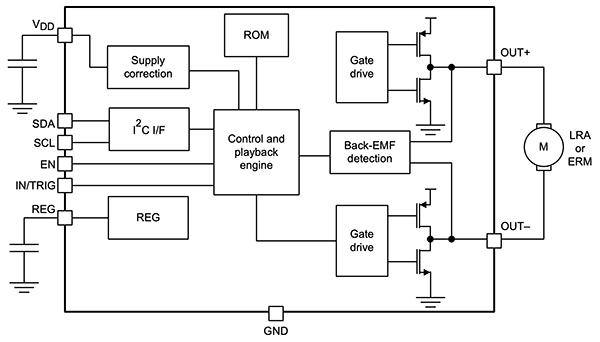 Figure 4: The DRV2605L IC can drive LRA or ERM haptic devices. (Image source: Texas Instruments)
Figure 4: The DRV2605L IC can drive LRA or ERM haptic devices. (Image source: Texas Instruments)
Vibration testing
Since haptic devices operate on the basis of vibration, it’s important that they be ruggedly constructed. PUI Audio has specified a test jig to be used for vibration testing, shown in Figure 5. The test is implemented with an industrial-grade electrodynamic vibration test system. It can be programmed for specific vibration tests to simulate various conditions such as sine vibration, random vibration, and mechanical shock pulse.
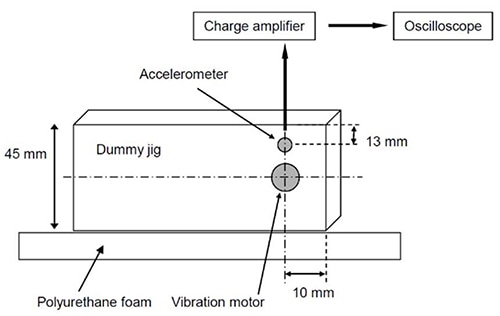 Figure 5: Recommended test jig for vibration testing of haptic devices. (Image source: PUI Audio)
Figure 5: Recommended test jig for vibration testing of haptic devices. (Image source: PUI Audio)
There are three vibration tests specified by PUI Audio for their haptic devices (see Table 1). After the testing has been administered, and the devices “rested” for four hours, they are required to meet the specifications for rated speed (for ERM devices) or acceleration (for LRA models), as well as resistance, rated current, and noise.
|
Table 1: Vibration test specifications for haptic devices. (Table source: PUI Audio)
In addition to vibration testing, PUI Audio has defined shock testing as follows:
- Acceleration: Half-sinusoidal 500 g
- Duration time: 2 milliseconds (ms)
- Test/face: 3 times/6 faces for a total of 18 shocks
The pass/fail criteria are the same as for vibration testing.
Measuring acoustic noise
The level of acoustic (mechanical) noise produced by haptic devices varies, with how the haptic device is mounted plays a key role in minimizing the noise level. PUI Audio recommends the use of a specific test setup for measuring the acoustic noise from haptic devices, shown in Figure 6. The test should be performed in a shielded room with 23 dBA of ambient noise. If the device is mounted to the 75 g jig as it will be installed in the system, this test will inform designers about the noise level to expect from the application.
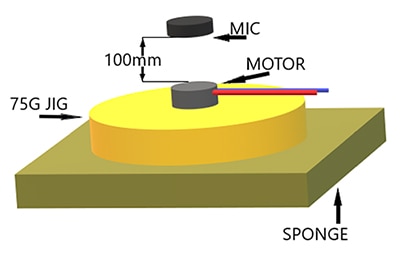 Figure 6: Recommended test jig for measuring haptic device acoustic noise. (Image source: PUI Audio)
Figure 6: Recommended test jig for measuring haptic device acoustic noise. (Image source: PUI Audio)
Conclusion
By providing tactile feedback to users, haptics can be used to improve HMI performance and help create high-performance multi-sensory environments. When considering the use of haptics, however, designers need to understand the tradeoffs between ERM and LRA technologies, how to effectively drive them, and how to test them to ensure that the needed levels of system reliability and performance are realized. As shown, haptic devices are readily available, as are drivers and test procedures.
Recommended Reading

Disclaimer: The opinions, beliefs, and viewpoints expressed by the various authors and/or forum participants on this website do not necessarily reflect the opinions, beliefs, and viewpoints of DigiKey or official policies of DigiKey.










